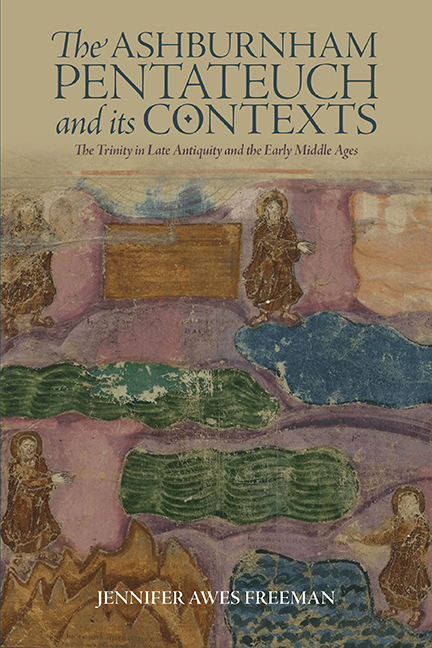Book contents
- Frontmatter
- Dedication
- Contents
- List of Illustrations
- List of Abbreviations
- Introduction: Losing and Finding the Ashburnham Pentateuch
- 1 Early Trinitarian Texts and Debates
- 2 The Trinity in Early Christian Images
- 3 Carolingian Conceptions of the Trinity
- 4 Carolingian Image Theory
- 5 The Carolingian Reception of the Ashburnham Pentateuch
- Conclusion: Possible Motivations for the Ashburnham Pentateuch Erasures
- Coda: The Afterlives of the Ashburnham Pentateuch
- Acknowledgments
- Bibliography
- Index
- ALREADY PUBLISHED
Conclusion: Possible Motivations for the Ashburnham Pentateuch Erasures
Published online by Cambridge University Press: 26 May 2022
- Frontmatter
- Dedication
- Contents
- List of Illustrations
- List of Abbreviations
- Introduction: Losing and Finding the Ashburnham Pentateuch
- 1 Early Trinitarian Texts and Debates
- 2 The Trinity in Early Christian Images
- 3 Carolingian Conceptions of the Trinity
- 4 Carolingian Image Theory
- 5 The Carolingian Reception of the Ashburnham Pentateuch
- Conclusion: Possible Motivations for the Ashburnham Pentateuch Erasures
- Coda: The Afterlives of the Ashburnham Pentateuch
- Acknowledgments
- Bibliography
- Index
- ALREADY PUBLISHED
Summary
Our course of inquiry has taken us from the early Christian controversies of the fourth and fifth centuries and contemporary depictions of the Trinity to the production of the Ashburnham Pentateuch in the sixth century, all the way to the political and theological contexts of the eighth and ninth centuries, during which time the Ashburnham Pentateuch was modified – perhaps in the monastery at Tours.
It is difficult to imagine a logical reason for the inconsistent erasure of the three Sons and one Father in the Ashburnham Pentateuch’s Creation image. Therefore, it seems safe to assume that this was not the redactor's actual intention. Because the majority of the targeted figures were the Son, we can suppose this to be the redactor's aim. While it is surprising that someone would erase the incarnate – and therefore imageable – Son, it is not without precedent. Still, the following analysis operates under the assumption that the redactor intended to erase four of the same figures and that the Son was indeed the target; the reasons behind such a decision could vary, as will be explained below. That said, the possibility must also be considered that there was a case of mistaken identity and that the Father could have been the intended target of erasure. This chapter will conclude by returning to the Ashburnham Pentateuch for a consideration of several possible motivations for its erasures. These include political, theological, and iconographic factors, some of which bear more weight than others.
ANTI-ADOPTIONIST
Because it was the first published suggestion for the motivations behind the erasures of the Ashburnham Pentateuch's Creation page, let us begin by considering Bezalel Narkiss's hypothesis regarding the anti-adoptionist sentiments of the Carolingians. In his initial article on the manuscript, Narkiss writes that:
The Adoptionists, Elipandus of Toledo and Felix of Urgel, basing their theories on Augustinian Christology, assumed Jesus Christ to be the Son [of] Man, merely adopted by the Father. The most vehement opponents of the Adoptionists were the theologians in the Court of Charlemagne, mainly Alcuin of York, who thought that it harked back to the Nestorian heresy, and, therefore, had the flavour of dualism. This may be the reason for crossing out the second image of [the] Creator in the Pentateuch.
- Type
- Chapter
- Information
- The Ashburnham Pentateuch and its ContextsThe Trinity in Late Antiquity and the Early Middle Ages, pp. 164 - 180Publisher: Boydell & BrewerPrint publication year: 2022



